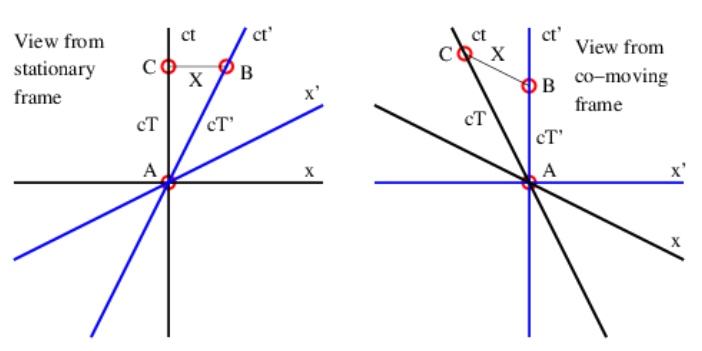4.4: Time Dilation
( \newcommand{\kernel}{\mathrm{null}\,}\)
Stationary and moving clocks run at different rates in relativity. This is illustrated in Figure 4.4.7:. The triangle ABC in the left panel of Figure 4.4.7: can be used to illustrate this point. Suppose that the line passing through the events A and C in this figure is the world line of a stationary observer. At zero time another observer moving with velocity V passes the stationary observer. The moving observer’s world line passes through events A and B.

We assume that events B and C are simultaneous in the rest frame, so ABC is a right triangle. Application of the space time Pythagorean theorem thus yields
c2T′2=c2T2−X2
Since the second observer is moving at velocity V , the slope of his world line is
cV=cTX
where the right side of the above equation is the slope calculated as the rise of the world line cT over the run X between events A and B. Eliminating X between the above two equations results in a relationship between T and T′:
T′=T(1−V2/c2)1/2≡T/γ
where
γ=1(1−V2/c2)1/2
The quantity γ occurs so often in relativistic calculations that we give it this special symbol. Note by its definition that γ≥1.
Equation (???) tells us that the time elapsed for the moving observer is less than that for the stationary observer, which means that the clock of the moving observer runs more slowly. This is called the time dilation effect.
Let us view this situation from the reference frame of the moving observer. In this frame the moving observer becomes stationary and the stationary observer moves in the opposite direction, as illustrated in the right panel of Figure 4.4.7:. By symmetric arguments, one infers that the clock of the initially stationary observer who is now moving to the left runs more slowly in this reference frame than the clock of the initially moving observer. One might conclude that this contradicts the previous results. However, examination of the right panel of Figure 4.4.7: shows that this is not so. The interval cT is still greater than the interval cT′, because such intervals are relativistically invariant quantities. However, events B and C are no longer simultaneous, so one cannot use these results to infer anything about the rate at which the two clocks run in this frame. Thus, the relative nature of the concept of simultaneity saves us from an incipient paradox, and we see that the relative rates at which clocks run depends on the reference frame in which these rates are observed.


